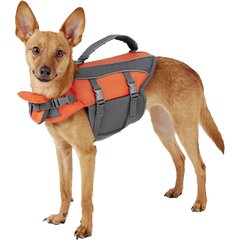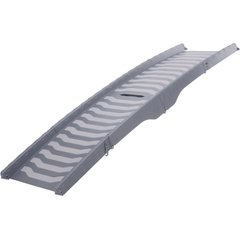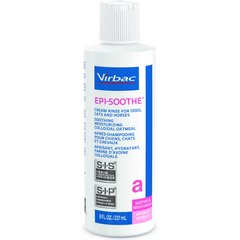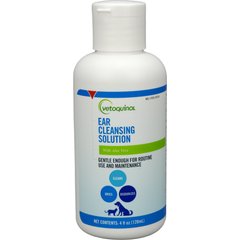7 Pool Safety Tips for Dogs
iStock/Paige_Rigoglioso
Summer is here, and it's only natural to want to be outside.
A big part of summer is swimming in the pool, but can your canine family members take part in the fun too? The short answer: Yes! But read on for a few things to keep in mind when it comes to dogs and pool safety.
As with humans, pool safety is key to keeping the good times going. When it comes to dogs and pools, many of them love the water and will take to it naturally, while others will benefit from a little swim training.
Whether or not your dog is a born swimmer, it's important to make your pool accessible for them when you are around, giving them easy ways in and out of the water, that will also keep your pool from being damaged.
Key Takeaways
- Make sure your pup is comfortable with water first, before letting them dive directly into a pool. Some pups are natural born swimmers, some are not.
- Life jackets are a great way to ensure your pup is safe during any water activity–no matter their swim style.
- Never leave a pup unattended near a pool.
Can Dogs Go Into Pools?
If precautions are taken, it can be safe to have a pool when you have fuzzy family members. Making your pool environment safe for you and your dog, whether or not you invite them in for a swim, will keep everyone safe, happy, and prepared for a great summer.
Consider:
-
How your dog can easily and safely get in and out of the pool—are the stairs easy to access?
-
Getting a pool fence to keep them away altogether (especially if you keep a solar cover on your pool)
-
Ensuring your dog is always supervised when they are in or around the pool. Never leave your dog unattended near a swimming pool.
Pool Safety Tips for Dogs
Install a Pool Fence
Sometimes a fence blocks off a general part of the yard, keeping younger children and fur children away from the pool.
But perimeter fences, which can be installed temporarily, go around the border of the pool itself, leaving an entrance open and only a couple of inches away from the very edge of the pool. The best dog pool safety measure is preventing your pup from getting in when no one is available to watch them.
If you don’t want a pool fence, an outdoor gate will let your pup enjoy the views deck-side, but keeps them from going near the pool.
Recommended Products
Teach Your Dog to Swim
While many dogs are natural swimmers and have the instinct to paddle, the thought that any dog can swim, isn’t actually true. Dogs and swimming pool safety starts with ensuring your dog is comfortable in the water.
If you want your dog to be prepared, safe, and confident in the water, consider swimming lessons! Training your dog to be comfortable in the water is the main goal, but teaching them to learn to swim properly is just as important.
Even better, it's great low impact exercise for dogs, especially older pups with mobility issues.
To teach your dog swimming without a trainer, start by carrying them into shallow water and lowering them down. They will probably start paddling their front paws, but this "method" ends up with a lot of splashing and not a lot of swimming.
Holding up the back of their bodies, under their waist, will keep them from ending up in a vertical position and help them start to paddle their rear paws as well.
Use positive reinforcement and praise to help your pup swim to the pool steps in the beginning, then stick by their side as they start to venture out and perfect their paddle.
Don’t forget, any activity you do with your furry friend is a great bonding opportunity! Sharing their water adventures, including training them, will build trust between you and your dog, making them feel even safer while in the water.
Invest In a Dog Life Jacket
During dog swimming training a great way to keep them afloat is using a life jacket. A life jacket or flotation device is also in case they tire easily, which is something to keep in mind with younger pups, larger breeds and senior dogs.
Life jackets can also come in handy for breeds that want to join in the fun with their humans but aren't natural swimmers. If your dog has a large head, short snout, flat face, or short legs like English and French Bulldogs and other brachycephalic breeds, invest in a reliable life jacket before considering a trip to the pool.
Recommended Products
Always Supervise Your Dog Around Water
The most important thing to remember when letting your pup play in the water with you is to always keep an eye on them. There are several things to look out for before, during, and after your dog is in the pool:
Watch out for dogs drinking pool water. Every dog (and human) who gets in the pool will inhale some pool water, but watch out for excessive drinking.
Pools treated with chlorine can be harmful to ingest if your dog drinks too much. The same goes for salt water pools; too much salt is never good for a pup. And if your pup is hot and exhausted from being outdoors and swimming, they're going to want to drink it to quench their thirst.
Fortunately, the amount of chlorine in the pool water is very diluted. Symptoms are mild and include mild gastrointestinal issues, but it's still a good idea to stop your dog from drinking too much of it. Drinking too much salt water however can have more serious consequences especially if the dog is dehydrated.
Never leave your dog unattended near a swimming pool.
Keep fresh water and a portable dog bowl nearby so your pup has access to clean drinking water at all times.
Watch to see if your dog gets tired. Dogs who are enjoying themselves in the pool may not notice they're getting tired. If you notice the rear part of their body sinking a bit, that's a good sign that they're becoming fatigued and could use a break.
This is when a life vest or flotation device can save them from slipping beneath the water's surface, but if you don't have one for your dog, ensure that they have a safe and easy way to get out of the pool.
Pool ramps, steps, and ladders for dogs will give your pup a safe spot to exit and take a breather before jumping in again. Providing a reliable access point for them will also help during training and if your dog gets nervous in the water.
Recommended Products
Check your dog's paws and ears. Chlorinated water is safe for your dog to swim in, but too much of a good thing can take its toll.
As with humans, too much exposure to chlorine can cause dry skin, and if you notice your dog licking their paws after being in the pool, their pads could be irritated.
Chlorine can also affect their fur, making it dry or even changing the color. If your dog is a frequent pool guest, give them a rinse or a bath to remove the chlorine, and consider a conditioner for their fur before they get in the pool. For their paws, you can even use the same paw balm you use in the winter.
Recommended Products
While it's commonly thought to be a chlorine issue, water in the ears can lead to an infection if it goes untreated.
Dogs with floppy ears are especially prone to infections, so give the insides of your dog's ears a quick rub with a cotton ball and ear cleaner. If it seems like they're pawing at their ears or shaking their heads more than usual after a swim, or you notice redness in the ear canal, give your vet a call.
Recommended Products
If you think your dog might be a swimmer, invite them in. Just take a few precautionary measures and your dog can join you in the pool instead of watching from the air-conditioned house—unless that's what they prefer!
It's great exercise for you both and it's also a perfect way to strengthen the bond between you and your dog, building trust that lasts beyond pool season.





